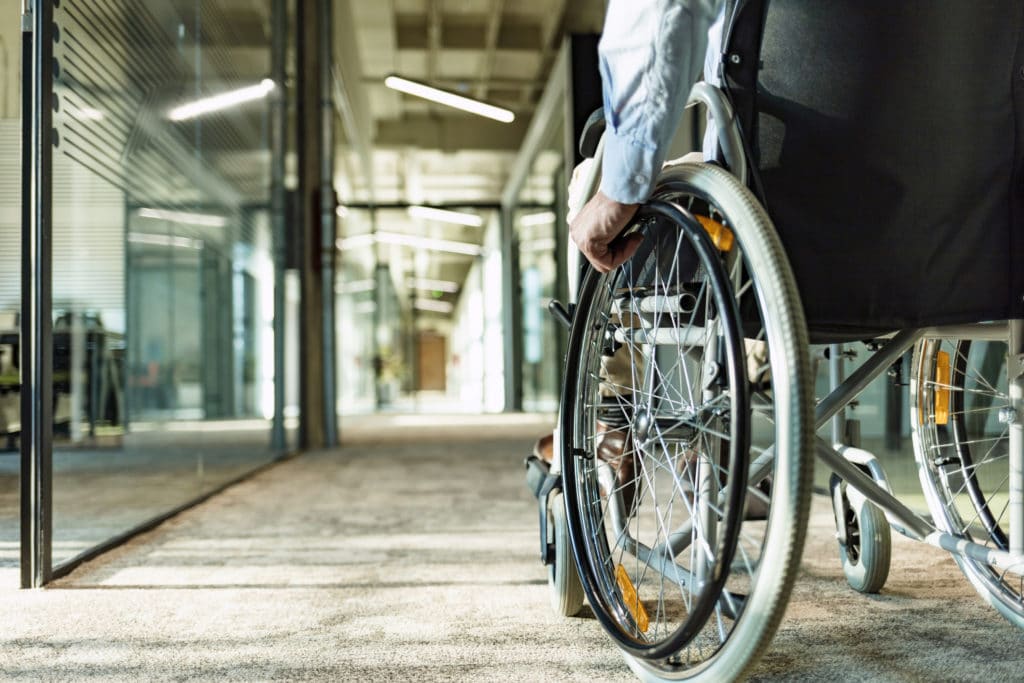5 Areas to Make Your Hybrid Event More Accessible & Inclusive

The adage “the more, the merrier” should come to mind when planning your hybrid events and direct you to create an inclusive event. You want everyone to have a positive experience, regardless of how they are attending. You should aim to accommodate attendees with limitations not only because the ADA requires it, but also because it’s the right thing to do. Here are 5 areas to make your hybrid event more accessible for both virtual and in-person attendees.
Attendees with Mobility Challenges
For those who prefer to attend your event in-person, ensure that your venue can accommodate physical limitations. Consider the following:
Is there an elevator or ramp access? When researching venues, some will indicate on their website whether they can accommodate visitors with physical limitations. In addition to an elevator, a parking lot with a cut curb or ramp will give those in wheelchairs or scooters easy access to the building. The building entrance also needs to be wide enough. If it’s not included on the venue’s website, a quick call or email should yield accessibility details.
Is your venue easy to access (for all attendees)? If your event takes place in a bustling metro location, what’s the best route for attendees to take? Is construction taking place nearby? Provide this information in your registration materials to save attendees time and make it easy for them to reach the venue. If some attendees use wheelchairs and will be arriving by subway or train, provide the link to Google’s Wheelchair Accessible Routes.
Is there nearby parking? For attendees using wheelchairs, canes, and walkers, available parking needs to be close to the venue entrance.
What’s the seating set-up? Is there enough space in the seating area to accommodate wheelchairs, scooters, canes, walkers, and service animals (this is important, as other attendees may be uncomfortable being near animals)? Having a designated area for those with physical disabilities is ideal to ensure that their needs are met.
Accessible hotel room options: When reserving a hotel block, include rooms that accommodate people with physical limitations.
Attendees with Hearing Challenges
For deaf and hard-of-hearing attendees, you should plan to accommodate both those who attend virtually and in person.
Will you provide an interpreter? For hearing-impaired attendees, will you employ the services of a sign language expert? Will you provide assistive listening devices? American Sign Language (ASL) includes signs for many words; however, there isn’t a sign for everything. Provide interpreters with written program materials in advance so they can decide how best to express unfamiliar terms to hearing-impaired attendees.
People born with the ability to hear may rely on other forms of communication besides ASL, so captioning video content (for both virtual and in-person attendees) will be helpful. Insist that speakers and attendees use microphones and always face forward to allow for lip-reading. If you’re planning to have background music, this could be distracting to hearing-impaired attendees trying to hear what speakers are saying.
Lastly, when implementing a captioned service, always try to include captions in other languages. This allows for world-wide reach, instead of only a local demographic.
Attendees with Visual Challenges
3.8 million U.S. adults are blind or have trouble seeing, even with glasses according to a 2020 study.
For visually impaired attendees, ensure that sufficient lighting and print materials are easy to read (minimum 16pt sans serif font on gloss-free paper). Blind attendees may request handouts printed in Braille or screen-reading software (virtual attendees).
Let Attendees Know They’re Covered
Make sure attendees know the steps you’re taking to make your event accessible to all. To do this:
- Include accessibility information in event promotion materials.
- Ask about the following during registration: (1) dietary restrictions, (2) need for an interpreter, (3) need for accessible parking or seating.
- Always list a contact from your organization for accessibility concerns from attendees.
- Mobility, hearing, and visual impairments are often accommodated at events, but what about those sensitive to event elements like flashing or strobe lights? Sudden loud noises may affect veterans or victims of trauma. Ask attendees for other conditions that may affect their experience during registration and be mindful when planning your experiences.
Ensure Website Accessibility for All
All digital (formally virtual) and in-person attendees to your hybrid event should be able to access event information and registration easily. To create an accessible website:
- Ensure all website text is easy to read.
- Provide larger buttons and plenty of space between buttons for those with low vision.
- The website should be accessible via keyboard instead of via mouse.
- Use descriptive link text.
- Provide video captions and transcripts.
- Eliminate CAPTCHA (spam discourager); it’s not easy for attendees with low vision to access.
Final Thoughts
It will take more thought and work to make your hybrid event more inclusive, but if it makes your special-needs attendees more comfortable, it’ll be worth it. Always gather feedback after your event to see if you hit the mark. Did attendees feel they were able to participate fully? Use their responses to continually improve on your accessibility efforts.
Consult disability groups and resources such as the ADA for planning guidance and solutions. Use the information gathered with eShow’s Registration Management system and attendee profiles, as well as the interactive Exhibit Sales & Floor Plan Management module to create an accessible floor plan.

This is a sponsored message from one of Association Forum’s advertisers. The opinions expressed in this advertisement do not constitute endorsement by Association Forum.
Tags
Related Articles
ASGE’s Commitment to Supporting the LGBTQ+ Physicians in GI through Allyship and Education
Read about one association's efforts to pave the way for equity and inclusion for the...
How to Celebrate AAPI Heritage Month
Asian Americans have made tremendous contributions to the association industry and the diverse fabric of...
How to Celebrate Arab American Heritage Month
Whether you celebrate as an organization or an individual, April is a time to appreciate...




